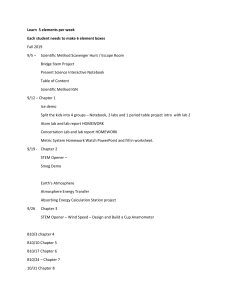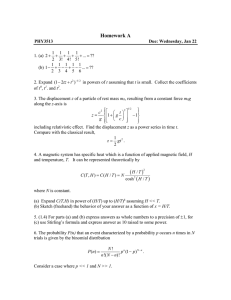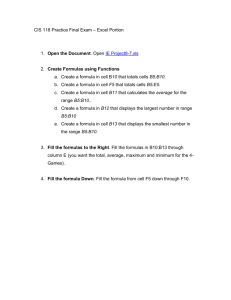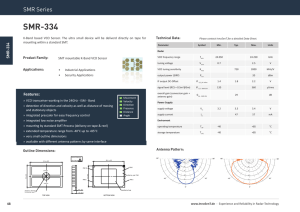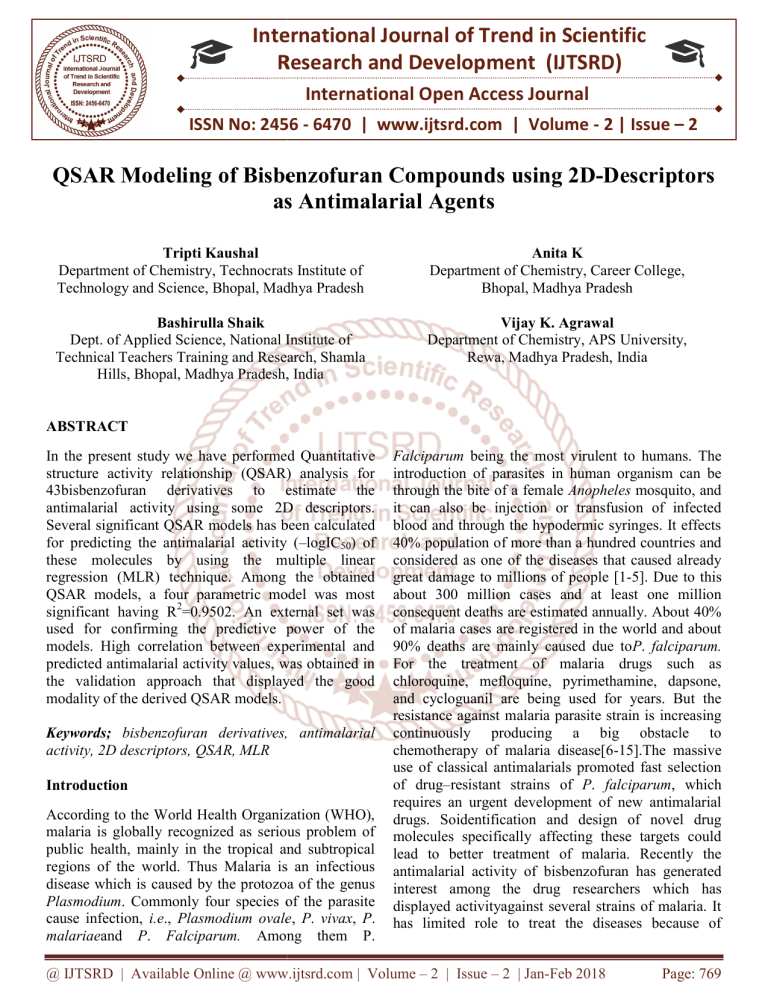
International Journal of Trend in Scientific
Scie
Research and Development (IJTSRD)
International Open Access Journal
ISSN No: 2456 - 6470 | www.ijtsrd.com | Volume - 2 | Issue – 2
QSAR Modeling off Bisbenzofuran Compounds using
sing 2D-Descriptors
2
ass Antimalarial Agents
Tripti Kaushal
Department of Chemistry, Technocrats Institute of
Technology and Science, Bhopal, Madhya Pradesh
Anita K
Department of Chemistry, Career College,
Bhopal,
pal, Madhya Pradesh
Bashirulla Shaik
Dept. of Applied Science, National Institute of
Technical Teachers Training and Research, Shamla
Hills, Bhopal, Madhya Pradesh, India
Vijay K. Agrawal
Department of Chemistry, APS University,
Rewa, Madhya Pradesh, India
ABSTRACT
In the present study we have performed Quantitative
structure activity relationship (QSAR) analysis for
43bisbenzofuran derivatives to estimate the
antimalarial activity using some 2D descriptors.
Several significant QSAR models has bee
been calculated
for predicting the antimalarial activity ((–logIC50) of
these molecules by using the multiple linear
regression (MLR) technique. Among the obtained
QSAR models, a four parametric model was most
significant having R2=0.9502. An external set was
used for confirming the predictive power of the
models. High correlation between experimental and
predicted antimalarial activity values, was obtained in
the validation approach that displayed the good
modality of the derived QSAR models.
Keywords; bisbenzofuran
zofuran derivatives, antimalarial
activity, 2D descriptors, QSAR, MLR
Introduction
According to the World Health Organization (WHO),
malaria is globally recognized as serious problem of
public health, mainly in the tropical and subtropical
regions of the world. Thus Malaria is an infectious
disease which is caused by the protozoa of the genus
Plasmodium.. Commonly four species of the parasite
cause infection, i.e., Plasmodium ovale
ovale, P. vivax, P.
malariaeand P. Falciparum. Among them P
P.
Falciparum being the most virulent to humans. The
introduction of parasites in human organism can be
through the bite of a female Anopheles mosquito, and
it can also be injection or transfusion of infected
blood and through the hypodermic syringes. It effects
40% population off more than a hundred countries and
considered as one of the diseases that caused already
great damage to millions of people [1-5].
[1
Due to this
about 300 million cases and at least one million
consequent deaths are estimated annually. About 40%
of malaria cases are registered in the world and about
90% deaths are mainly caused due toP.
to falciparum.
For the treatment of malaria drugs such as
chloroquine, mefloquine, pyrimethamine, dapsone,
and cycloguanil are being used for years. But the
resistance against malaria
alaria parasite strain is increasing
continuously producing a big obstacle to
chemotherapy of malaria disease[6-15].The
disease[6
massive
use of classical antimalarials promoted fast selection
of drug–resistant
resistant strains of P. falciparum, which
requires an urgent development
lopment of new antimalarial
drugs. Soidentification
identification and design of novel drug
molecules specifically affecting these targets could
lead to better treatment of malaria. Recently the
antimalarial activity of bisbenzofuran has generated
interest among the drug researchers which has
displayed activityagainst several strains of malaria. It
has limited role to treat the diseases because of
@ IJTSRD | Available Online @ www.ijtsrd.com | Volume – 2 | Issue – 2 | Jan-Feb
Feb 2018
Page: 769
International Journal of Trend in Scientific Research and Development (IJTSRD) ISSN: 2456-6470
protonation of its amidine group at physiological pH,
pentamidineand also shows low oral availability.
Drugrequiresparentral administration which makes the
treatment less practical in rural areas. Pentamidine is
tolerated by most patients in spite of some reported
serious adverse effects [16, 17, 18].In this context it is
very appropriate to search for options to find a potent
antimalarial compound with improved potency and
oral availability. Computational chemistry is an
important tool to rational drug design. The
quantitative structure-activity relationship (QSAR)
approach by Hansch et al. helps to correlate the
specific biological activities of compounds with the
molecular properties of the compounds. The authors
have successfully reported use of topological
parameters for modeling antimalarial activity of 4pyridones against P. falciparum T9-96 strains[ 19].
Materials and Methods
In the present work an attempt was made to find out a
mathematical model which correlates the possible
structural requirements and biological activity of in
order to design of new and more potent compounds
with strengthened biological activities. An analysis
using the MLR method is applied to a series of
43bisbenzofurans derivatives with known biological
activity[20].The biological activity has been given in
terms of negative log of IC50 in order to convert the
data into free energy change related values.
Structural details of the
compound having
antimalarial activity (bisbenzofurancation) used in
present studyare given in Table-1.The parameters
used for modeling the activity are
VE1_D,
VE1_B(e), GATS7p, GATS8p , CATS2D_04_DA,
CATS2D_06_PL, B10[N-N], F08[C-C], DLS_07 ,
Psychotic-80 and cRo5. Here DLS_07 , Psychotic-80 ,
cRo5
are
Drug-like
indices
descriptors,
CATS2D_04_DA, CATS2D_06_PL, B10[N-N],
F08[C-C] are 2D Atom Pairs parameters, GATS7p,
GATS8p are 2D- autocorrelation parameters [21]and
VE1_D, VE1_B(e) are 2D matrix-based descriptors.
All these have been calculated using DRAGON
software[22] and for regression purpose NCSS was
used [23]. The calculated values along with biological
activity –log IC50are given inTable-2.The entire data
set given in table 1 has been divided into training and
test set and efforts have been made for obtaining the
best suitable model for modeling the -log IC50 value.
We have taken 31 compounds for training set and 12
compounds as test set. The generation of training and
test sets is done on random basis. For statistical
validation, variety of statistical parameters was
calculated. All these statistically significant
correlation models for the training set have been
reported below along with their statistical parameters.
RESULT AND DISCUSSION:
The correlation matrixes of these parameters
arereportedin Table-3 which clearly reveals that
F08[C-C] is highly correlated with VE1_D and
similarly B10[N-N] is highly correlated with
CATS2D_06_PL and Psychotic-80 is
highly
correlated F08[C-C]. Hence while dealing with these
parameters the collinearity defect should be checked.
Now, we will discuss the results obtained in
successive regression analysis. It is pertinent to
mention that the parameter which are auto-correlated
should not be used in multiparametric analysis
because they may result in to some defect in the
model.
Through variable selection four parameters were
selected and the data presented in Table-2 was
subjected to regression analysis which yields
significant models. These models along with their
quality are reported in Table-5.
ONE-PARAMETRIC MODEL:
Among all the models, the best one parametric model
contains B10 [N-N], having R2 value equal to 0.8459.
The model is as below:
-logIC50=2.0051(±0.1589) B10[N-N]+0.1149
(4.1.1)
N=31, Se = 0.1563, R2 = 0.8459, R2Adj= 0.8406, Fratio = 159.185, Q =5.8830
Here and here after N is total number of compounds ;
Se is the standard error of estimation;R2 is the square
of correlation coefficient;R2Adj is the adjusted R2;F is
the Fisher’s ratio and Q is the Pogliani’s quality
factor[24] which is the ration of R/Se (Pogliani,
1994,1996)
TWO-PARAMETRIC MODEL:
When cRo5 is added to the mono-parametric model,
two parametric models are resulted with improved R2
value. For this model R2 comes out to be 0.9211and
R2Adj also enhances from0.8406 to 0.9154. The model
is reported as under
IC50=2.0531(±0.1161)
cRo5+0.3550
B10[N-N]-0.2881(±0.0558)
(2)
N=31 , Se = 0.1138, R2 = 0.9211, R2Adj=0.9154, Fratio = 163.392 , Q =8.4292
@ IJTSRD | Available Online @ www.ijtsrd.com | Volume – 2 | Issue – 2 | Jan-Feb 2018
Page: 770
International Journal of Trend in Scientific Research and Development (IJTSRD) ISSN: 2456-6470
THREE-PARAMETRIC MODEL:
F08[C-C] has also been found to be an effective
parameter in modeling log IC50. When higher
parametric models were tried with B10_N_N_,
F08[C-C]as correlating parameters along with VE1_D
in modeling the antimalarial activity, a improvement
in the quality of the model is observed. For this
model, R2 comes out to be 0.9318.The value of R2Adj
changes from 0.9154 to 0.9242 suggesting that the
added parameter is favorable .The model is given
below:
IC50=2.1541(±0.1176) B10_N_N_+0.0241(±0.0044)
F08[C-C]-0.5575(±0.1052) VE1_D+2.2910
(3)
N= 31, Se = 0.1078, R 2= 0.9318, R2Adj= 0.9242, Fratio = 122.890, Q =8.9532
than SSY (sum of squares of response value) indicates
that the model predicts better than the chance and can
be considered statically significant. In our study, the
value of PRESS is much lower than SSY indicating
that all the models obtained are statically significant.
The ration of PRESS/SSY can be used to calculate
approximate confidence intervals of prediction of new
compounds. To be a reasonable and significant QSAR
model, the ratio PRESS/SSY should be less than 0.4
(PRESS/SSY < 0.4) and the value of this ratio 0.1
indicates an excellent model. A close observation of
Table-6 shows that except the one parametric model
(model1, Table4)all other models have the
PRESS/SSY ratio more or less or nearer to 0.1
indicating thereby all the proposed models are having
best predicting capacity.
FOUR -PARAMETRIC MODEL:
Finally,
by
adding
2Dautocorrelation
parametersGATS7p atetra - parametric model having
R2=0.9502 is found to be the best model for modeling
IC50 activity. The model contains B10 [N-N], F08[CC], GATS7p and VE1_D as correlating parameter.
The lowest values of SE and also highest value of Fratio and Q-value further confirm our results.
Addition of GATS7p is justified as R2Adj changes
from 0.9242 to 0.9425. The model is found as under:
IC50= 1.9399 (±0.1235)
B10[N-N]+0.0197
(±0.0041)
F08[C-C]-0.9062(±0.2920)
GATS7p -0.5498(±0.0916) VE1_D+3.3488
(4)
N=31, Se =0.0939, R2 =0.9502, R2Adj= 0.9425, F-ratio
=124.031, Q =10.3859
R2cv is the cross validation squared correlation
coefficient. The highest R2cv values 0.948 for four
parametric model [(Model-30 and Table-4);Fig.1]
confirms our findings. The two important crossvalidation parameters uncertainty in prediction
(SPRESS) and predictive squared error (PSE) were also
calculated. For this model, the value of SSY is
highest, whereas, the values of PRESS, PRESS/SSY,
SPRESS, and PSE have been lowest, conforming our
findings.
A close look at this model revels that out of four
parameters contained, two (GATS7p, VE1_D) are
having negative coefficients, while two of them are
positive (B10 [N-N], F08[C-C]). The predictive
potential of the model has been obtained by plotting a
graph between observed and estimated activity values
and such graph is demonstrated in Fig. 1.
PREDICTIVE POWER BASED ON CROSS
VALIDATION:
Leave –one –out cross (leave –one –out) validation
procedure”(Chaterjeeet al .,2000) is being widely
used to examine the suitability of predictive power of
the model[25]. The obtained results are reported in
Table-6 .As stated earlier the predicted residual sum
of square (PRESS) is the most important crossvalidation parameter accounting for good estimate of
the real predictive error of the model. Its value less
Final confirmation is obtained by calculating the
estimated values of -log IC50 for the entire set of
compounds using tetra parametric model and the
same has been reported in Table-5.These values are in
good agreement with the estimated value. Further
confirmation is obtained by plotting a graph between
observed and estimated -log IC50 values using four
parametric model, the predictive power for the model
comes out to be 0.9502, suggesting that 95 % variance
in the data could be explained using this model.
Therefore, this is the best model for modeling iogIC50 values of the compound used in this study.
The external predictive power of the model is
assessed by predicting pIC50 value of the 9 test set
molecules, which are not included in the QSAR
model development.
Further, VIF (variance inflation factor), Eigen values
(λi), condition number (k), tolerance (T) for all the
independent parameters have been calculated or all
the independent parameters used in the proposed
models and they are reported in Table-7.The
collinearity is observed if the value of VIF is greater
than 10. In the table all the combination have VIF less
@ IJTSRD | Available Online @ www.ijtsrd.com | Volume – 2 | Issue – 2 | Jan-Feb 2018
Page: 771
International Journal of Trend in Scientific Research and Development (IJTSRD) ISSN: 2456-6470
than 10 means all the proposed models are free from
collinearity. And if λi, (Eigen value) is found to be
greater than 5 then the model will suffer from
collinearity. Here all the models have λi value less
than 5 so all the models are free from the defect of
collinearity. Condition number is another test
forcollinearity if its value is found to be >100 then the
collinearity exists but results indicate that values
always <100 likewise. . Tolerance value equal to 1 or
less indicates absence of collinearity Table-7 indicates
that all the above mentioned parameters or models
discussed in the study are free from multi-collinearity.
The ridge traces are recorded in fig.-2 and fig.-3
respectively.
CONCLUSION:
1. Positive coefficient of B10[N-N] suggests that
presence/absence of N - N at topological distance 10
plays a dominant role in deciding the antimalarial
activity of present set of compounds.
2. The coefficient of both the GATS7p and VE1_D
parameters are negative. Therefore molecules having
higher value of polarizability and topological distance
matrix should be avoided in designing synthesizing
new compounds for better activity. Compounds with
low value of these parameters will certainly give
better activity.
Table 1 Structures of bisbenzofurancation used in the present study
1
2
3
NH2
HN
O
H N
NH
N H
H N
NH2
O
N H
O
O
O
H N
4
NH
O
H N
H N
H N
5
6
HN
H 2N
NH
O
O
N
O
O
HN
H 2N
O
N
H
O
NH
HN
7
8
9
NH
O
H2N
H
N
O
NH
O
O
O
HN
O
N
HN
N
H2N
10
HN
O
H2N
O
N
N
H
HN
O
NH
O
HN
O
NH
14
15
O
O
NH
NH
O
O
O
N
NH
NH
NH2
NH
O
NH2
HN
NH
12
O
13
N
NH
NH
11
N
N
H
N
NH
NH
HN
NH
NH2
@ IJTSRD | Available Online @ www.ijtsrd.com | Volume – 2 | Issue – 2 | Jan-Feb 2018
Page: 772
International Journal of Trend in Scientific Research and Development (IJTSRD) ISSN: 2456-6470
16
17
18
O
H 2N
HN
O
O
N
NH
N
HN
NH
HN
19
21
O
O
O
O
O
HN
NH
NH
NH2
NH
NH
22
NH
23
24
NH
H 2N
NH
NH
HN
O
HN
NH2
NH
O
O
O
N
NH
O
O
NH
25
26
27
HN
HN
NH
N
O
NH
NH2
NH2
N
H 2N
N
NH
NH
O
NH
O
O
NH
O
NH 2
NH
O
O
28
29
30
N H
N
H
N
H
2
NH
N
NH
N H
N
O
NH
N H
O
N
H
O
HN
O
33
NH2
H N
HN
N
O
34
N H
H N
NH2
N H
O
O
32
N H
O
NH
2
O
31
N
NH
NH2
20
N
N
H
O
NH
O
HN
O
O
N H
O
O
35
O
O
O
O
36
@ IJTSRD | Available Online @ www.ijtsrd.com | Volume – 2 | Issue – 2 | Jan-Feb 2018
Page: 773
International Journal of Trend in Scientific Research and Development (IJTSRD) ISSN: 2456-6470
N
NH
H 2N
N
NH
O
HN
HN
NH
O
O
O
O
O
37
O
NH 2
38
N
HN
N
H
NH
2
NH
HN
H
H 2N
2N
NH
O
O
O
O
40
41
NH2
HN
2
NH
N
H
O
NH
39
N
O
NH
O
NH
H N
N H
42
2
H N
H
H 2N
2
N H
2
H
N
O
O
N
H
O
O
O
2
N
N H
NH
O
43
H N
N H
2
H
2
N
N H
O
O
@ IJTSRD | Available Online @ www.ijtsrd.com | Volume – 2 | Issue – 2 | Jan-Feb 2018
Page: 774
International Journal of Trend in Scientific Research and Development (IJTSRD) ISSN: 2456-6470
Table -2 values of the calculated descriptors along with their activity values
S.
IC50
VE1_D VE1_B GATS7p GATS8p CATS2D CATS2D
No.
(e)
B10
F08
_04_DA
_06_PL
[N-N]
[C-C]
DLS_07 Psychotic-
cRo5
80
1*
0.068
4.617
4.07
0.978
1.078
2
2
0
10
1
1
1
2*
0.918
5.084
4.05
1.13
1.092
0
0
1
21
1
1
1
3
2.12
4.647
3.939
0.917
1.14
0
3
1
11
1
1
1
4*
0.028
4.541
3.844
1.087
1.054
0
0
0
11
1
1
1
5
0.102
4.987
3.941
1.047
1.102
0
0
0
20
1
1
1
6
0.034
4.843
3.789
1.14
0.98
0
0
0
17
1
1
1
7
0.022
4.294
3.641
1.127
1.032
0
0
0
12
1
1
1
8*
0.003
5.131
3.844
0.987
1.064
0
0
0
18
0.5
1
1
9
0.003
5.045
3.962
1.044
1.153
0
0
0
22
1
0
1
10
0.011
4.908
3.909
1.115
1.028
0
0
0
19
1
1
1
11
0.002
4.599
3.892
1.144
1.223
0
1
0
13
1
1
1
12
0.006
5.038
3.99
1.082
1.087
0
0
0
22
1
0
1
13
0.046
4.894
3.935
1.071
1.09
0
0
0
19
1
1
1
14
0.004
4.599
3.728
1.236
1.176
0
2
0
13
1
1
1
15
0.005
5.038
3.817
1.104
0.96
0
0
0
24
1
0
1
16
0.034
4.908
3.761
1.012
1.161
0
0
0
19
1
1
1
17* 0.041
4.714
3.873
1.109
1.118
0
0
0
16
1
1
1
18* 0.009
5.109
3.97
1.071
1.135
0
0
0
25
1
0
1
19* 0.004
4.866
3.873
1.224
1.081
0
1
0
18
1
1
1
0.037
4.683
3.736
1.256
1.142
0
2
0
16
1
1
1
21* 0.036
5.095
3.825
1.127
0.969
0
0
0
27
1
0
1
0.353
4.958
3.784
1.006
1.194
0
0
0
22
1
1
1
23* 0.032
4.817
3.877
1.145
1.15
0
0
0
20
1
1
1
24
0.01
5.182
3.974
1.097
1.157
0
0
0
29
1
0
1
25
0.026
5.062
3.922
1.168
1.057
0
0
0
26
1
1
1
26* 0.058
4.779
3.74
1.282
1.171
0
2
0
20
1
1
1
0.076
5.159
3.829
1.152
1.004
0
0
0
31
1
0
1
28* 0.164
5.031
3.788
1.043
1.213
0
0
0
26
1
1
1
29
0.067
4.926
3.878
1.087
1.181
0
0
0
23
1
1
1
30
0.02
5.266
3.976
1.063
1.18
0
0
0
32
0.5
0
1
31
0.067
5.156
3.923
1.118
1.088
0
0
0
29
1
0
1
32
0.066
5.329
3.861
1.06
1.043
0
0
0
29
0.5
1
1
33* 0.133
5.661
3.945
1.025
1.129
0
0
0
42
0.5
0
1
0.11
5.56
3.9
1.041
1.161
0
0
0
35
1
0
1
20
22
27
34
@ IJTSRD | Available Online @ www.ijtsrd.com | Volume – 2 | Issue – 2 | Jan-Feb 2018
Page: 775
International Journal of Trend in Scientific Research and Development (IJTSRD) ISSN: 2456-6470
35
0.057
4.888
3.741
1.214
1.202
0
2
0
23
1
1
1
36
0.018
5.233
3.83
1.115
1.037
0
0
0
34
0.5
0
1
37
0.133
5.116
3.789
0.998
1.237
0
0
0
29
1
0
1
38
0.364
4.989
3.879
1.056
1.125
0
0
0
26
1
1
1
39
0.279
4.822
3.879
1.049
1.093
0
0
0
27
1
0
0
40
0.694
4.419
3.879
1.042
1.084
0
0
0
28
1
0
0
41
0.296
4.674
3.879
1.037
1.076
0
0
0
29
0.5
0
0
42
0.287
4.952
3.879
1.032
1.069
0
0
0
30
0.5
0
0
43
0.219
5.146
3.879
1.028
1.063
0
0
0
31
0.5
0
0
VE1_D =coefficient sum of the last eigenvector from topological distance matrix (2D matrix-based descriptors)
VE1_B(e)= coefficient sum of the last eigenvector from Burden matrix weighted by Sanderson
electronegativity( 2D matrix-based descriptors)
GATS7p =Geary autocorrelation of lag 7 weighted by polarizability (2D autocorrelations)
GATS8p =Geary autocorrelation of lag 8 weighted by polarizability (2D autocorrelations)
CATS2D_04_DA= CATS2D Donor-Acceptor at lag 04 (CATS 2D)
CATS2D_06_PL= CATS2D Positive-Lipophilic at lag 06 CATS (2D Atom Pairs)
B10[N-N] =Presence/absence of N - N at topological distance 10 (2D Atom Pairs)
F08[C-C] =Frequency of C - C at topological distance 8 (2D Atom Pairs)
DLS_07= modified drug-like score from Veber et al. (2 rules)( Drug-like indices)
Psychotic-80= Ghose-Viswanadhan-Wendoloski antipsychotic-like index at 80% (Drug-like indices)
cRo5 =Complementary Lipinski Alert index (Drug-like indices)
Table 4.1.3 Correlation matrix
IC50
VE1_D
VE1_B(e) GATS7p GATS8p CATS2D_
06_PL
B10
[N-N]
IC50
1
VE1_D
-0.290
1
VE1_B(e)
0.166
0.424
1
GATS7p
-0.561
-0.170
-0.402
1
GATS8p
0.084
-0.014
0.026
-0.111
1
CATS2D_06_PL
0.512
-0.403
-0.251
0.261
0.360
1
B10[N-N]
0.920
-0.206
0.170
-0.432
0.085
0.628
1
F08[C-C]
-0.214
0.718
0.329
-0.218
-0.123
-0.557
-0.356
DLS_07
0.036
-0.285
-0.131
0.205
0.204
0.203
0.089
Psychotic-80
0.079
-0.394
-0.356
0.257
0.147
0.401
0.177
cRo5
-0.200
0.237
-0.090
0.296
0.189
0.182
0.080
@ IJTSRD | Available Online @ www.ijtsrd.com | Volume – 2 | Issue – 2 | Jan-Feb 2018
Page: 776
International Journal of Trend in Scientific Research and Development (IJTSRD) ISSN: 2456-6470
F08[C-C]
DLS_07
Psychotic-80
F08[C-C]
1
DLS_07
-0.517
1
Psychotic-80
-0.723
0.343
1
cRo5
-0.341
0.451
0.453
cRo5
1
Table 4 Regression Parameters and Quality of Correlation
Ai = (1-----4)
B
SE
R2
R2Adj
F-ratio
Q=R/SE
DLS_07
0.0710 (±0.3618)
0.1155
0.3980
0.0013
0.0000
0.038
0.0906
02
Psychotic_80
0.0609 (±0.1427)
0.1482
0.3970
0.0062
0.0000
0.182
0.1983
03
GATS8p
0.4605 (±1.0130)
-0.3303
0.3968
0.0071
0.0000
0.207
0.2123
04
VE1_B_e_
0.7731 (±0.8536)
-2.8061
0.3927
0.0275
0.000
0.820
0.4223
05
cRo5
-0.2091(±0.1906)
0.3550
0.3902
0.0399
0.0068
1.204
0.5119
06
F08[C-C]
-0.0125(±0.0106)
0.4773
0.3891
0.0456
0.0127
1.386
0.5489
07
VE1_D
-0.4217(±0.2582)
2.2654
0.3811
0.0842
0.0526
2.667
0.7614
08
CATS2D_06_PL
0.2536 (±0.0789)
0.0978
0.3420
0.2626
0.2372
10.327
1.4985
09
GATS7p
-3.0310(±0.8296)
3.4705
0.3296
0.3152
0.2916
13.348
1.7036
10
B10[N-N]
2.0051 (±0.1589)
0.1149
0.1563
0.8459
0.8406
159.185
5.8830
11
B10[N-N]
2.1527 (±0.2031)
0.1274
0.1554
0.8529
0.8424
81.195
5.9418
CATS2D_06_PL
-0.0534(±0.0461)
B10[N-N]
2.0383 (±0.1604)
0.1482
0.1553
0.8531
0.8426
81.313
5.9462
Psychotic_80
-0.0665(±0.0567)
B10[N-N]
1.9578 (±0.1595)
0.8738
0.1535
0.8565
0.8463
83.582
6.0286
VE1_D
-0.1531(±0.1063)
B10[N-N]
2.1064 (±0.1645)
-0.0703
0.1512
0.8608
0.8508
86.559
6.1352
F08[C-C]_
0.0076 (±0.0044)
B10[N-N]
1.8150 (±0.1588)
1.3047
0.1409
0.8791
0.8704
101.768
6.6524
GATS7p
-1.0902(±0.3934)
B10[N-N]
2.0531 (±0.1161)
0.3550
0.1139
0.9211
0.9154
163.392
8.4292
cRo5
-0.2881(±0.0558)
B10[N-N]
2.0441 (±0.1161)
0.0110
0.1135
0.9243
0.9159
109.961
8.4688
cRo5
-0.2993(±0.0566)
GATS8p
0.3194 (±0.2959)
Model
Parameters
no
Used
01
12
13
14
15
16
17
@ IJTSRD | Available Online @ www.ijtsrd.com | Volume – 2 | Issue – 2 | Jan-Feb 2018
Page: 777
International Journal of Trend in Scientific Research and Development (IJTSRD) ISSN: 2456-6470
18
19
20
21
22
23
B10[N-N]
1.6839 (±0.1503)
GATS7p
-1.3914(±0.3696)
VE1_D
-0.2545(±0.0917)
B10[N-N]
2.0441 (±0.1161)
cRo5
-0.2993(±0.0566)
GATS8p
0.3194 (±0.2959)
B10[N-N]
2.0418 (±0.1128 )
cRo5
-0.3331(±0.0605 )
DLS_07
0.1874 (±0.1127)
GATS7p
-0.5630(±0.330)
cRo5
-0.2518(±0.0580 )
B10[N-N]
1.9489 (±0.1280)
B10_N_N
2.1541 (±0.1176)
F08[C-C]
0.0241 (±0.0044)
VE1_D
-0.5575(±0.1052)
B10[N-N]
1.9040 (±0.1308 )
cRo5
-0.2806(±0.0614 )
GATS7p
24
25
26
27
0.1266
0.9059
0.8955
86.651
7.5179
0.0110
0.1135
0.9243
0.9159
109.961
8.4688
0.2238
0.1104
0.9284
0.9205
116.710
8.7250
0.3466
0.1102
0.9287
0.9208
117.279
8.7461
2.2910
0.1078
0.9318
0.9242
122.890
8.9532
1.0557
0.1087
0.9332
0.9229
90.733
8.8833
-0.0005
0.1077
0.9344
0.9243
92.610
8.9744
1.8367
0.1073
0.9349
0.9249
93.381
9.0117
2.1885
0.1067
0.9357
0.9258
94.543
9.0678
1.7237
0.1053
0.9373
0.9277
97.182
9.1933
-0.6753(±0.3374 )
Psychotic_80
0.0602 (±0.0459)
B10[N-N]
2.1076 (±0.1180 )
cRo5
-0.3207(±0.0595 )
DLS_07
0.2707 (±0.1225)
F08[C-C]
0.0057(±0.0037)
B10[N-N]
1.8582 (±0.1373)
cRo5
-0.2114(±0.0621 )
GATS7p
-0.8065(±0.3573)
VE1_D
-0.1343(±0.0854)
B10[N-N]
2.1734 (±0.1174)
DLS_07
0.1452 (±0.1155)
F08[C-C]
2.8947
0.0272 (±0.0050)
VE1_D
-0.5780(±0.1054)
B10[N-N]
2.1271 (±0.1163)
cRo5
-0.1239(±0.0817)
F08[C-C]
0.0166(±0.0066)
@ IJTSRD | Available Online @ www.ijtsrd.com | Volume – 2 | Issue – 2 | Jan-Feb 2018
Page: 778
International Journal of Trend in Scientific Research and Development (IJTSRD) ISSN: 2456-6470
28
29
30
VE1_D
-0.3850(±0.1533)
B10[N-N]
2.1824 (±0.1155)
F08[C-C]
0.0308 (±0.0060)
Psychotic_80
0.0926 (±0.0571 )
VE1_D
-0.6044(±0.1062)
B10[N-N]
1.9208 (±0.1222)
cRo5
-0.2982(±0.0597)
DLS_07
0.2156 (±0.1075)
GATS7p
-0.6447(±0.3162)
B10[N-N]
1.9399 (±0.1235)
F08[C-C]
0.0197 (±0.0041)
GATS7p
-0.9062(±0.2920)
VE1_D
-0.5498(±0.0916)
2.3142
0.1047
0.9380
0.9285
98.405
9.2508
0.8730
0.1045
0.9383
0.9288
98.803
9.2698
3.3488
0.0939
0.9502
0.9425
124.031
10.3859
Table 5 observed and estimated IC50 values Using model 30 (Table 4)
Model No.
Obs. pIC50
Est. pIC50
Residual
1*
0.068
0.12111
-0.0531
2*
0.918
1.88321
-0.9652
3
2.12
2.12
0
4*
0.028
0.08382
-0.0558
5
0.102
0.053
0.049
6
0.034
-0.011
0.045
7
0.022
0.204
-0.182
8*
0.003
-0.012
0.01504
9
0.003
0.063
-0.06
10
0.011
0.015
-0.004
11
0.002
0.04
-0.038
12
0.006
0.033
-0.027
13
0.046
0.063
-0.017
14
0.004
-0.043
0.047
15
0.005
0.052
-0.047
16
0.034
0.108
-0.074
17*
0.041
0.06727
-0.0263
18*
0.009
0.06183
-0.0528
@ IJTSRD | Available Online @ www.ijtsrd.com | Volume – 2 | Issue – 2 | Jan-Feb 2018
Page: 779
International Journal of Trend in Scientific Research and Development (IJTSRD) ISSN: 2456-6470
19*
0.004
-0.0811
0.08512
20
0.037
-0.048
0.085
21*
0.036
0.05818
-0.0222
22
0.353
0.146
0.207
23*
0.032
0.05681
-0.0248
24
0.01
0.078
-0.068
25
0.026
0.021
0.005
26*
0.058
-0.0464
0.10444
27
0.076
0.081
-0.005
28*
0.164
0.14979
0.01421
29
0.067
0.11
-0.043
30
0.02
0.122
-0.102
31
0.067
0.074
-0.007
32
0.066
0.031
0.035
33*
0.133
0.13493
-0.0019
34
0.11
0.04
0.07
35
0.057
0.015
0.042
36
0.018
0.133
-0.115
37
0.133
0.204
-0.071
38
0.364
0.162
0.202
39
0.279
0.28
-0.001
40
0.694
0.528
0.166
41
0.296
0.412
-0.116
42
0.287
0.283
0.004
43
0.219
0.2
0.019
Est. pIC50
2.5
2
1.5
1
0.5
0
-0.5 0
y = 0.950x + 0.009
R² = 0.950
y = 2.069x - 0.051
R² = 0.979
1
2
Obs.pIC50
Traini
ng
3
Fig.1 Correlation between observed and estimated pIC50
@ IJTSRD | Available Online @ www.ijtsrd.com | Volume – 2 | Issue – 2 | Jan-Feb 2018
Page: 780
International Journal of Trend in Scientific Research and Development (IJTSRD) ISSN: 2456-6470
Table 6 Cross validated parameters for the best obtained models
Parameters used
PRESS
SSY
PRESS/SSY
R2cv
SPRESS
PSE
10
B10[N-N]
0.709
3.891
0.182
0.818
0.156
0.071
16
B10[N-N]
0.363
4.236
0.086
0.914
0.114
0.061
0.314
4.286
0.073
0.927
0.108
0.059
0.229
4.37
0.052
0.948
0.094
0.055
Model
no
cRo5
22
B10[N-N]
VE1_D
F08_C_C_
30
B10_N_N_
F08_C_C_
VE1_D
GATS7p
Table 7 Ridge regression parameters for the best obtained models.
Model no
Parameters used
VIF
T
10
B10[N-N]
1.0000
1.0000
1.0000
16
B10[N-N]
1.0065
0.9936
1.080064
1.00
cRo5
1.0065
0.9936
0.919936
1.17
B10[N-N]
1.1520
0.8680 1.895320
1.00
VE1_D
2.0735
0.4823 0.840262
2.26
F08_C_C_
2.2741
0.4397 0.264419
7.17
B10[N-N]
1.6753
0.5969 1.903822
1.00
F08_C_C_
2.5824
0.3872 1.420041
1.34
VE1_D
2.0750
0.4819 0.449074
4.24
GATS7p
1.5276
0.6546 0.227063
8.38
22
30
λi
K
1.0000
VIF = Variance Inflation Factor
T = Tolerance
λi = Eigen values
k = Condition number
@ IJTSRD | Available Online @ www.ijtsrd.com | Volume – 2 | Issue – 2 | Jan-Feb 2018
Page: 781
International Journal of Trend in Scientific Research and Development (IJTSRD) ISSN: 2456-6470
Ridge Trace
StandardizedBetas
1.00
Variables
VE1_D
GATS7p
B10_N_N_
F08_C_C_
0.65
0.30
-0.05
-0.40
10-4
10-3
10-2
10-1
K
100
Fig.2 Ridge trace for four variable model
Variance Inflation Factor Plot
VIF
101
Variables
VE1_D
GATS7p
B10_N_N_
F08_C_C_
100
10-1
10-4
10-3
10-2
K
10-1
100
Fig. 3 VIF plot for four-variable model
8) R.Arav-Boger,
T.
Shapiro;
PharmacolToxicol;2005,45,565.
REFERANCE:
1) F.Nosten,
F.
TerKuile,
T.Chogsuphajaisiddhi,C.Luxemburger,H.K.Webst
er&M.Edstein, L.Phaipun,K. L.Thew& N. J.
White; Lancet;1982,331,1140.
2) A.M.Oduola,W.K.Milhous,L.A.Salako&O.Walker
; Lancet;1987,2,1304.
3) P. Carson, C. Flanagan, C.E.Lekes& A. Alvin;
Science;1956,124,484.
A.Anna;Rev
9) B.P. Das, D.W. Boykin;JMedChem;1977,20,531.
10) J.
Anne,
E.D.
Cierec,
H.Eyssen&O.
Dann;AntimicrobAgentsChemother;1980,18, 231.
11) R.R.Tidwell,C.A. Bell, J.E. Hall, D.E.Kyle,M.
Grogl;Antimicob Agent Chemother;1990,34,1381.
12) R.R.Tidwell,S.K.Jones,J.D.Geratz, K.A.Ohemeng,
M. Cory, J.E. Hall; JMedChem; 1990,33,1252.
4) P.E. Carson, C.I.Flanagan,C.E.Lakes,A.S. Alvin;
Science;1982,31,427.
13) J.J.Brendle, A. Outlaw,A. Kumar,D.W. Boykin,
D.A.Patrick,R.R.Tidwel,K.A.Werbovetz;Antimicr
ob Agents Chemother;2007,46,4761.
5) H.L.
Schmdt,R.Frank,C.S.Genther,
R.N.Rossan&W.I. Squires; Am J Trop Med
Hvg;1982,31,612.
14) P.G. Bray,M.P.Barrett,S.A.Ward,H.P. De Koning;
Trends Parasitol; 2003,19.232.
6) J.L.Bras,R.
FundanClinPharmacol;2003,17,147.
7) J.E. Hyde; Trends Parasitol;2005,21,494.
Durand;
15) M.Stead,P.G. Bray, I.G. Edward, H.P. De Koning,
B.C.Elford, P.A. Stocks & S.A. Wardol;
Pharmacol,2001,59,2001,1298.
16) A.H.Fairlamb;TrendsParasitol; 2003,19,488.
@ IJTSRD | Available Online @ www.ijtsrd.com | Volume – 2 | Issue – 2 | Jan-Feb 2018
Page: 782
International Journal of Trend in Scientific Research and Development (IJTSRD) ISSN: 2456-6470
17) R.
Docampo,
Res;2003,90,510.
S.N.
Moreno;
Parasitol,
18) R.J.Burchomore, P.O. Ogbunude,B. Enanga, M.P.
Barrett;curr Pharm LDes;2002,8,256.
19) B.Shaika, T.Kaushal and V. K. Agrawal ; J.
Indian Chem. Soc., 2016,93,876.
20) S.Paliwal, J.Sharma and S.Paliwal ; Indian
Chem., 2012,51B,617.
J.
21) D. Legros,G.Ollivier,M.E. Gastellu, C. Paquet,C.
Burri,lancetInfec Dis,2002,2,437
22) Dragon Software for calculation of Topological
Indoses,www.disat.unimib,it.
23) NCSS, statistical analysis software,www.ncss.com
(Accessed May 2005)
24) S.Cheterjee, A.S.Hadi, B. Price; Regression
analysis by Examples,3rd.ed.; Wiley &Sons:New
York;6,141-153.
25) L. Pogliani,Structure Property Relationship Of
Amino Acids and Some Dipeptide, Amino
acids;1994,6,141-15
@ IJTSRD | Available Online @ www.ijtsrd.com | Volume – 2 | Issue – 2 | Jan-Feb 2018
Page: 783

